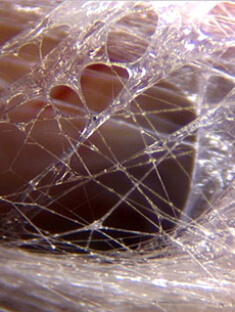Studies have shown certain nerves within the skin can take around 2 minutes to send a signal and receive one back. These nerves respond best to a light touch. Their signals are easily lost amongst those from muscles stimulated by deep pressure. Bowen’s light moves and frequent pauses enable the skin nerve signals to get through and create a response within your body.
Key to this response is your fascia.
Fascia is the connective tissue which wraps around and through our muscles and organs. You will have seen it when pulling the skin off a chicken breast. It is the opaque fine substance which holds the skin onto the muscles beneath. Fascia allows everything inside us to glide around as we move.
Fascia is integral to our postural alignment and flexibility. When we suffer from a trauma, injury, or continually adopt a poor posture our fascia can contract and become stiffer, which we experience as aching muscles and painful joints. The fluidity within our organs becomes less, inhibiting their function and our body has to use more energy every day.
It would be the same for your car if it was running with unbalanced wheels or soft tyres - it uses more fuel and the steering wheel starts to shudder or pull as the force of movement can no longer travel through the chassis correctly.
Damage to the fascia can manifest its effect locally (scar tissue) or remotely and over time. An example might be a foot or ankle injury causing micro shortening and distortion in tendons and muscles from the legs up into the back and onto the head, perhaps causing headaches months later.
Fascia appears to be a major communication pathway; it facilitates the messaging from nerves to the brain and back again as a continual self-regulating feedback mechanism.
The Bowen moves send a signal through this communication pathway to your brain, which assesses length and tension throughout your body and signals back to make changes within the musculature. These changes may occur quite quickly, or more time may be needed to release long-held patterns, if this is possible. Sometimes it can return to this state very quickly, or more time may be needed to undo and release protective compensations first. Sometimes your body can never fully return to its original state, perhaps because of scar tissue, but it will get as close as it can.

Magnified Fascia
